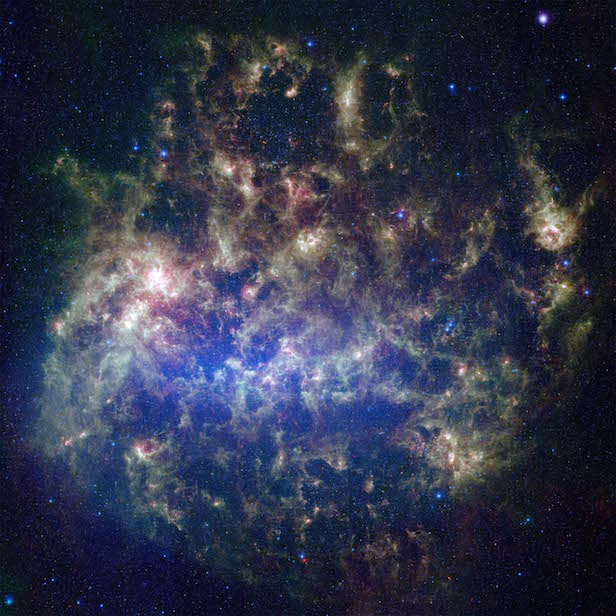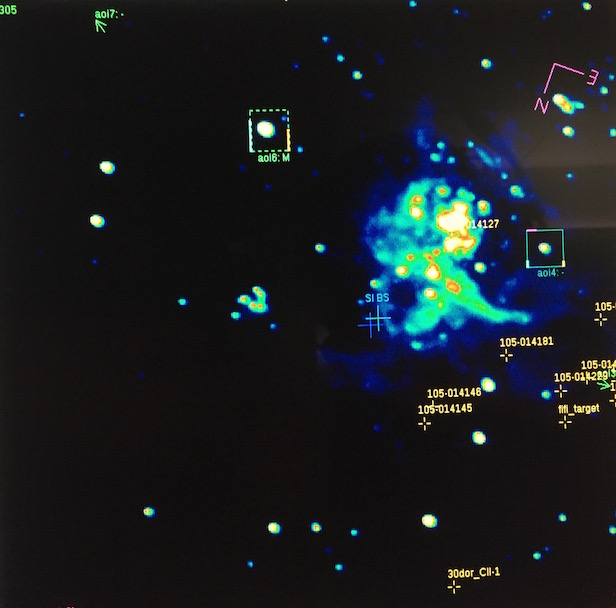Astronomers hunt for stars inside the Tarantula Nebula
By using the stratospheric observatory SOFIA, researchers hope to see the birth of massive stars outside our Milky Way

The LMC is the third-closest galaxy to the Milky Way 163 thousand light years away. Image credit: NASA/JPL-Caltech/STScl
To get the full story of the life of a star, astronomers need to observe different stars are different points in their lives. This includes when a star isn’t even born yet, so just the cloud of gas and dust it’s birthed from, to a star on the verge of a final supernova explosion. To observe the former, NASA’s airborne observatory, the Stratospheric Observatory for Infrared Astronomy – or SOFIA – set to the skies to observe the Tarantula Nebula. The Tarantula nebula is a star-forming region, consisting of vast amounts of gas and dust, located within the Large Magellanic Cloud – or LMC.
Michael Gordon of the Minnesota Institute for Astrophysics led his team of researchers, also from the same institute, as they flew aboard SOFIA in the hunt for stellar nurseries. More specifically, they wanted to identify and characterise the brightness, ages and dust content of three young star-forming regions in the LMC.
“The Large Magellanic Cloud has always been an interesting and excellent laboratory for massive star formation,” says Gordon. “The chemical properties of star-forming regions in the LMC are significantly different than in the Milky Way, which means the stars forming there potentially mirror the conditions of star formation in dwarf galaxies at earlier times in the universe.”
LMC resides within our galactic neighbourhood, and it is commonly accepted that massive stars form exclusively in very dense molecular clouds, much like the ones found in the LMC. These massive stars are classified as stars that have at least eight times the mass of our Sun. However, the gas and dust encompassing newly born stars tend to absorb background light, making it hard for traditional optical telescopes to image the complete situation.

SOFIA’s visible light guide camera was used during the observations of the Tarantula Nebula. Image credit: NASA/SOFIA/N. A. Veronico
“The mid-infrared capabilities of SOFIA are ideal for piercing through infrared dark clouds to capture images of potential massive star-forming regions,” Gordon says. SOFIA’s infrared capabilities include the Faint Object Infrared Camera for the SOFIA Telescope, also known as FORCAST, which was used to make the observations. This infrared camera also performs spectroscopy, which identifies the elements present.
By observing the optical and infrared light emitted from stars, astronomers can learn more about the photosphere, and the population of stars in the photosphere. The mid- and far-infrared data collected by SOFIA has proved consistent with previous research about dust temperature and mass accretion rates in the LMC.
“We want to combine as many observations as we can from the optical, as seen through images from the Hubble Space Telescope, all the way out to the far infrared, imaged using the Spitzer Space Telescope and the Herschel Space Observatory, to get as broad a picture as possible,” Gordon continues. “No previous researchers have used FORCAST’s wavelength range to effectively study massive star formations. We needed SOFIA to fill in the 20- to 40-micron gap to give us the whole picture of what’s taking place.”
SOFIA accomplished a six-week science campaign handled by Christchurch, New Zealand. This six-week project had the aim to study the sky in the Southern Hemisphere, and led to this vital research of the Tarantula Nebula. Gordon and collaborators hope that the data from these flights will reveal previously undiscovered young massive stars forming within the region. These particular regions have never been observed outside the Milky Way.
Keep up to date with the latest reviews in All About Space – available every month for just £4.99. Alternatively you can subscribe here for a fraction of the price!




